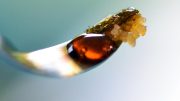
As marijuana legalization grows, various cannabinoids are appearing in the market, including hexahydrocannabinols (HHCs). Recent research by UCLA has illuminated HHC properties and introduced a safer production method. However, legal clarity and further research are essential, with the U.S. DEA deeming HHCs illegal.
UCLA chemists develop method for producing a form of the substance that acts more predictably and consistently.
- In the fast-growing marketplace for recreational marijuana and related products, products containing cannabinoids called HHCs are gaining popularity.
- The neurological and physiological effects of HHCs are not well understood.
- A new study by UCLA chemists is the first to explain how well HHCs bind to receptors in the human body.
- The scientists also devised a safer way to produce HHCs than the current standard process.
With the increasing legalization of marijuana across the nation, there has been a surge in the number of products available in dispensaries. These products often contain THC, the psychoactive ingredient in marijuana, and other cannabinoids which can either be derived from THC or the plant itself.
Cannabinoids are a group of substances that interact with cannabinoid receptors in the body and brain. While THC, found in the cannabis plant, is the most recognized cannabinoid, there are numerous other classes being sold in dispensaries today. The neurological or physiological effects of many of these classes remain poorly understood.
This lack of clarity has led to a “wild west” scenario in the marijuana marketplace, posing challenges for governments striving to regulate these products and establish comprehensive laws regarding their usage.
Research Efforts and Findings
UCLA chemist Neil Garg is one of a group of scientists who are rapidly learning more about emerging cannabinoids. Their goals include ensuring the safety of products being sold to consumers and helping government agencies develop evidence-based laws for the fast-growing industry.
A new research paper by Garg and colleagues takes a close look at one class of those emerging cannabinoids: hexahydrocannabinols, or HHCs. The study systematically evaluates how well HHCs bind to receptors in the human body.
“The compounds have been tested in animals before, but the basic binding assays of each isomer were somehow not done or not reported,” said Garg, UCLA’s Kenneth N. Trueblood Professor of Chemistry and Biochemistry, a UCLA distinguished professor and the paper’s senior author. “That is unusual for a product that’s widely available to consumers, and it reflects the need for more fundamental research in this rapidly evolving field.”
HHC products on the market today typically contain a mixture of two different versions, or isomers, of the HHC molecule. In the new study, the scientists found that although both isomers bind to the same cannabinoid receptors in the body as THC does, only one of the isomers binds as well as THC does — which suggests that it is the only HHC isomer with effects comparable to THC.
The paper, published on August 14 in ACS Chemical Biology, also describes a new method for synthesizing the more biologically active of the two HHC isomers.
Production Methods and Safety Concerns
Most HHCs found in commercially available products are synthesized from THC by manufacturers using a process called catalytic hydrogenation. This technique produces both isomers of HHC in variable ratios. As a result, there is little consistency in the amount of each HHC isomer in HHC products — not only from one brand to the next but even among batches produced by the same manufacturer. And because the ratios are variable, some HHC products being sold to consumers contain relatively little of the more biologically active isomer.
Garg and Daniel Nasrallah, a UCLA assistant adjunct professor of chemistry, developed a method that relies instead on a chemical process called hydrogen atom transfer. Using their method to produce HHCs yields roughly 10 times more of the biologically active isomer than the less active one.
The new method also is safer than catalytic hydrogenation, a process that uses hydrogen gas, which when not handled carefully can lead to laboratory fires. Labs that use catalytic hydrogenation also often use potentially toxic heavy metals like platinum or palladium as part of the process.
“If a medical drug was being synthesized using these metals, careful analysis would be required to ensure these metals are not present in the final commercial products in order to avoid any toxicity concerns,” Garg said.
Nasrallah said that generally is not happening now. “Typically, HHCs being sold for recreational use are not analyzed for the presence of platinum or palladium,” he said.
The Need for More Research and Legal Clarifications
Garg stressed that further research on cannabinoids and their effects is essential.
“These studies are crucial if we are to have laws and policies that are fair and allow for consumer safety, while allowing scientists and society alike to explore the potential therapeutical effects of new cannabinoids,” he said.
The paper notes that although there is a popular belief that HHCs are legal under federal law, the U.S. Drug Enforcement Agency (DEA) considers them illegal.
Reference: “Studies Pertaining to the Emerging Cannabinoid Hexahydrocannabinol (HHC)” by Daniel J. Nasrallah and Neil K. Garg, 14 August 2023, ACS Chemical Biology.
DOI: 10.1021/acschembio.3c00254
The new study on HHCs was funded by ElectraTect Inc., a startup company spun out of Garg’s UCLA research, and performed with an appropriate DEA license. Earlier this year, Garg and UCLA collaborators received a $2 million grant from the California Department of Cannabis Control to evaluate new cannabinoids.









Wonderful and informative write up. That said, placing “the Truth” in the title is somewhat beneath what I’ve come to expect from the site. Yes, it’s just the title. But I think you can do better.
Actually, it’s exactly what I expect from scitechdaily. It’s a press release. TheInsightPost posted the exact same article.
It’s more of an indictment of UCLA’s public relations department. Imagine summarizing scientific research as “the truth”; these chemists must be turning in their labs. Scitechdaily could edit and catch these things better, knowing its audience, but curating press releases is a service too.